June 2010 (An amazing month full of lifers)
The more birding you set out to do, the higher your lifelist will get. New species become less and require a lot more luck to find. As my list is still fairly moderate, I had a decent lifelist going into the month of June 2010, of 331 species. I was proud to have hit that 300 and more mark and have had luck since then. The lifer abundance trims down a lot, especially after the 300 mark, with only several of those 300 species listed being outside of Arizona. But June was a different story, as I shockingly added more lifers in a month in the state of Arizona since the first year of my birding in 2000.
The month really started on May 31st, 2010. I sat down to read the Arizona/New Mexico Birding Listserv around eight o' clock that night. I had just gotten back from a trip out to the Agua Fria Riverbed and Glendale Recharge Ponds in the west Glendale/Phoenix area. An Elegant Tern was found by fellow Arizona birder John Saba on May 30th, which I got to see the evening he found it. When I pulled up to Agua Fria that next night, I could see the large tern perched almost shoreside, where I got better looks than the previous night. I felt good going into June, as Elegant Tern is one heck of an Arizona rarity. As I sat down to report the tern's continuing presence, another report caught my attention, which made me forget about my further tern report. Janet Witzeman, the author of the Phoenix and Maricopa County birding guide, posted that her husband, Bob, had found a Red Phalarope on Higley Road out in Gilbert, at several nice ponds. I had been to the Higley Ponds previously many times, and I always thought they would be great to attract rarities. Janet mentioned how much she hoped the bird would stay for another day, which would give Arizona it's first June Red Phalarope record. I hoped it stayed too, especially because of the fact it was a nice lifer for me and a rare one indeed. It would also be good for the Maricopa County big year I was working on, which already had Wilson's and Red-necked Phalaropes on it. A Red would give me the perfect addition.
When the time came around on June 1st the next day, I had to wait until three in the afternoon to head out to Gilbert, due to my work schedule. I felt I had a decent chance to see this bird, as I checked the listserv and saw that people were still continuing to see the Red Phalarope. As I was getting closer, my friend Jim Kopitzke called me and said he was on the bird, who showed no signs of leaving as he left. Jim called me when I first saw the bird, and the last time. By the last time he called me, I was only 20 minutes away. I arrived at Higley just after four, and ran to the pond Red was at. Almost immediately, I saw the bird! It was beautiful and striking, not many shorebirds are colorful like the Red. The phalarope waded in the shallow pond in front of me, and I watched in amazement. Twenty more curious birders and two hours later, I was still watching the bird. Among the other birders, my buddy and photographer Brendon Grice came to see the bird, as well as Brian Holiday, another photographer, perhaps the top two avian photographers in the state. Everyone had fun seeing the Red Phalarope, who's presence contined for several more days after June 1st.
RED PHALOROPE at Higley Road Ponds, June 1st 2010 (below)
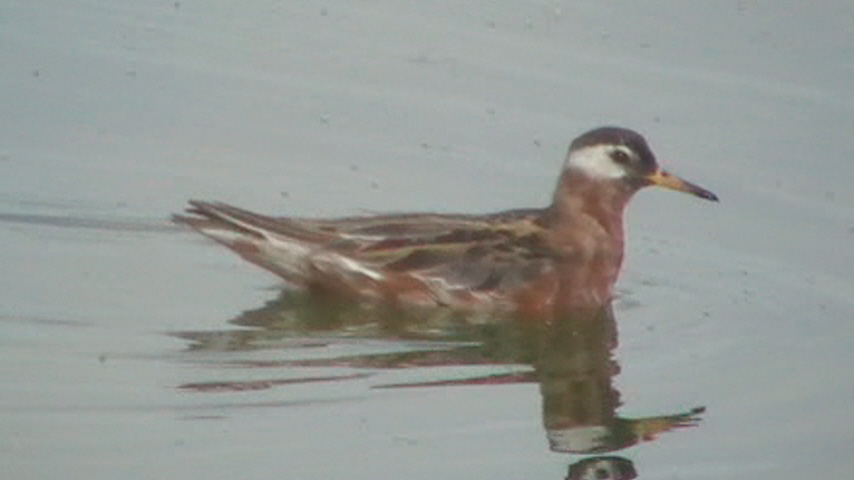
Two days after the phalarope excitement, I went with my friend Justin Jones to the Agua Fria Riverbed and Glendale Recharge Ponds on June 3rd. Justin and I had planned a southeastern Arizona camping trip for the weekend on June 5th and 6th, which was bound to be good. As we were busy talking about our trip as we arrived at the riverbed, we were excited to notice a very large gull flying over the waters. We thought by it's size and shape that this gull was most likely a Herring Gull. I managed to get decent video and we were confident about the bird's identification. When I returned home I sent pictures to Kurt Radamaker, an excellent birder who has experience with gulls. Kurt said Herring was the best fit for what I had photographed and described field marks that were very relevant for a Herring Gull by the pictures. This bird was a lot bigger than any California Gull, which I saw a few weeks prior at Gilbert Water Ranch.
HERRING GULL at Agua Fria Riverbed on June 3rd, 2010 (below, my crappy shot!)
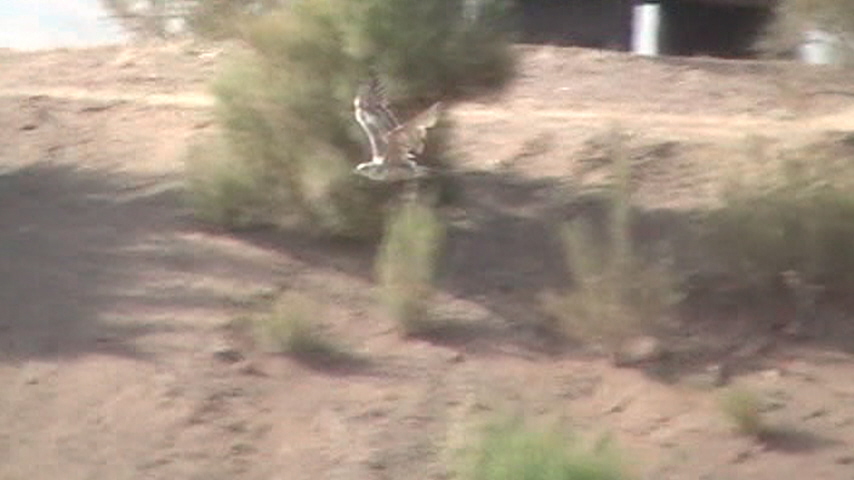
At three in the morning once June 5th came, Justin and I headed for southeastern Arizona. Miller Canyon and the Beatty's Guest Ranch was our first destination. Several very good birds here were potential lifers here for me, one for Justin. Having been birding in Arizona for more than twenty years, Justin wasn't missing a lot. The Berylline Hummingbird was his nemisis howver. He had tried for years without success. It would be a lifer for me as well of course, and Miller Canyon was also home to the Spotted Owl, which are very reliable walking up the canyon. I also wanted the White-eared and Blue-throated Hummingbirds, and many of the local specialty flycatchers. Good news for Justin, it was just a matter of time, the Berylline was being seen regularly on a daily basis, as a male and female made the immediate area their home. As we started on the dirt road entrance to the canyon, Justin said, "Tommy, let's put our binoculars on right now as we're driving down the road. We need to look like hardcore's".
Beatty's Guest Ranch is located in Miller Canyon and is at the base of a trail that goes up canyon six miles to the summit of Miller Peak. It is run by Tom Beatty Sr., and Tom Beatty Jr, father and son. The Beatty's had a hummingbird station, which brought in all the excitement. After a conversation with Tom Beatty Jr., we headed over to the feeders. As we were walking, a heard a loud squeak call from a bird, which I caught sight of as it flew into a sycamore tree. A Sulphur-bellied Flycatcher! A new lifer! I didn't see it well at first, but one eventually gave me great views an hour or so later. These unique flycatchers are distinctive without any other species like it. Once at the hummingbird station, Justin and I waited. My second lifer of the day came in, the giant Blue-throated Hummingbird, which was accompanied by the similar-sized Magnificent Hummingbird. Both of these hummers are southeast Arizona specialties, seeing a Blue-throat for the first time was a pleasure. They made an unusual high squeak note as they would fly away. About thirty mintues into watching the feeders, Justin finally got the lifer he had tried years for, and it was my third lifer in such a short time into the day. The Berylline Hummingbird came and sat on a feeder in front of us. This bright green hummer has a distinctive brown back and wing coloring, and was beautiful. I think I got more enjoyment seeing Justin get this bird so easily, that he tried so many times on before. The Berylline came in several times while we were there. Recent posts said it came in once about every hour. Justin and I got great views several times. Tom Beatty Jr. concluded that they nested somewhere very close to the feeders, as they would see the birds gathering nesting material. I wanted to see that nest, but finding it was another story. The hummingbird I wanted to see the most however was the White-eared Hummingbird, another specialty of southeastern Arizona. To me, they are the most beautiful U.S. hummingbird and I waited and hoped one would come in, as Miller Canyon is probably the best location in the United States to see this species. But they didn't visit the feeders during the day while we were there for several hours. Tom Beatty Jr. informed us that they stopped coming down to the feeders for awhile, but in most years, they do that and usually return in a couple weeks and then visit the feeders very regularly. Justin said, "Don't worry Tommy, you'll get one, the Berylline is actually much more of a rarity than the White-eared". After two hours of birding, we loved Miller Canyon and payed the money to stay overnight.
SULPHUR-BELLIED FLYCATCHER at Miller Canyon on June 5th, 2010 (below)
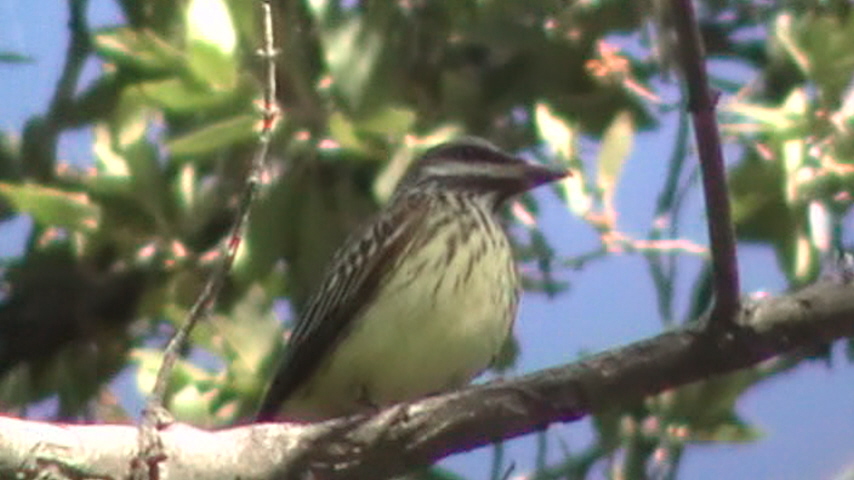
BLUE-THROATED HUMMINGBIRD at Miller Canyon on June 5th, 2010 at the Beatty's feeders (below)
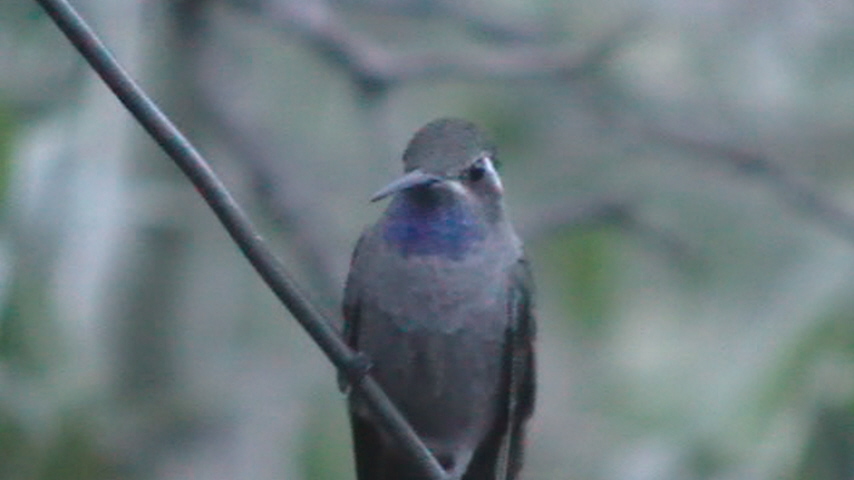
BERYLLINE HUMMINGBIRD at Miller Canyon on June 5th, 2010 at the Beatty's feeders (below)
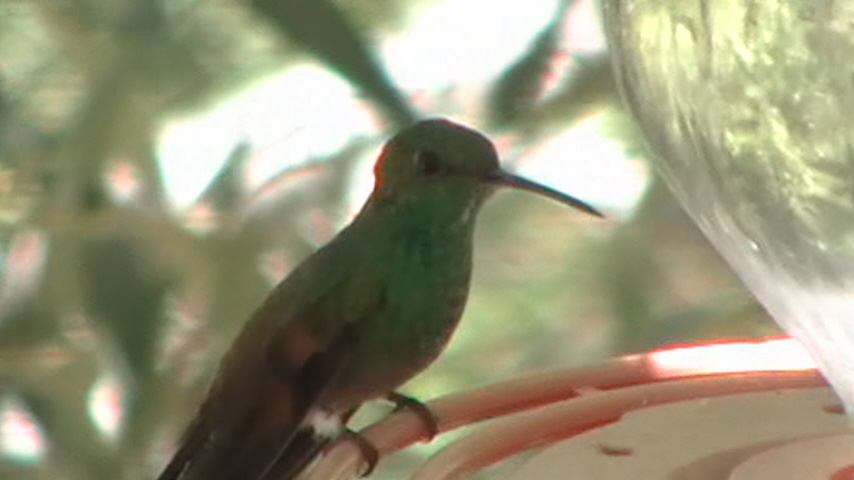
Next, Justin and I hiked up Miller Canyon for several miles in search of the Spotted Owls and other things. After looking hard both up and down the canyon, we struck out on the owls. However, I did hear a lifer, which was a Greater Pewee. This bird called and called. "Hosay, hosay, mariiaa!" It never came close however and I had to leave it unseen. Then, I had plenty of Dusky-capped Flycatchers come into view while they vocalized, which sounded like a depressed mourning bird. Their calls haunt the canyons of southeast Arizona and are always a great thing to hear, despite the fact the bird sounds so mournful. The first time I had Dusky-capped Flycatcher in the wild was at Madera Canyon on April 9th, 2010, where they were heard only. By the end of this hike, the Dusky-capped Flycatcher and the Greater Pewee had traded places. Justin also almost stepped on a Black-tailed Rattlesnake as we were on our way down. As we were leaving Miller for a few hours we saw Border Patrol agents running up into the canyon after an illegal immigrant.
Justin and I then left and jumped between canyons throughout the day. We arrived at the closeby Ash Canyon right around noon when we finished Miller, at the Ash Canyon Bed and Breakfast. This bed and breakfat is run by Mary Jo Ballator, who does an excellent job with hummingbird species. Over the years, her hummingbird feeders have brought in rarites such as Plain-capped Starthroat and Lucifer Hummingbird. The Lucifer Hummingbirds were what Justin and I were after. As we got there during the heat of the day, not many hummers came to the feeders, especially not the Lucifer. We remembered previous posts on the Listserv saying the evening was the best time to observe the Lucifer Hummingbirds. After an hour or so later in the heat, we decided to go elsewhere for a few hours. Those few hours were unproductive and we returned to the Ash Canyon Bed and Breakfast around four thirty. About two hours later after twenty or more birders came, a female Lucifer finally came down to the feeders. I got a brief but good look at her. The species decurved bill is one of its key identification marks, and it was amazing to see that on the bird. As more people came, Justin and I decided to leave, we never did get to see the amazing male Lucifer Hummingbird. Once back at Miller Canyon in the evening, Justin and I went back to the hummingbird feeders where we ran into fellow local birders, Melanie Herring and Barb Meding. We enjoyed more close up views of the Berylline Hummingbird and many others. Melanie and Barb had been birding at the St. David area during the day at the St. David Monastery, where they both had seen Mississippi Kites, a lifer for both Justin and I. We made St. David a priority stop for the next day. That night, I got another "heard only" lifer as we were starting up camp, a Whiskered Screech-Owl. They were everywhere. However, from earlier in the day, illegal immigrants had been through Miller Canyon and Border Patrol was running up into the canyon. Justin and I were too scared to owl, and eventually were too scared to stay at Miller Canyon and camp. We drove into town and gave up on camping in the freaky Miller Canyon.
Early in the morning the following day, we headed back up Miller Canyon. I wanted another shot at the Spotted Owls. The light of the day certainly took away the scary thoughts from the previous night. The morning was something to enjoy, but once again, I struck out on the Spotted Owls.
|
